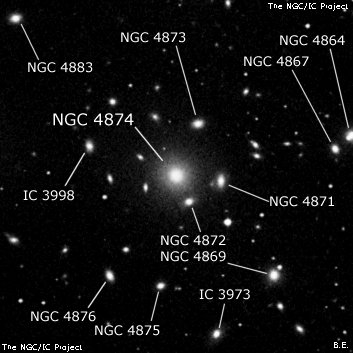
William Herschel discovered NGC 4874 = H II-389 = h1502 on 11 Apr 1785 (sweep 396) and recorded "Two [along with NGC 4864], the time taken between them." His position (CH's reduced position) is 2.5' northwest of NGC 4874, in line with his offset of 3.5' northwest for NGC 4889. Dreyer misassigned II-389 = h1502 to nearby NGC 4872, but this is a much fainter companion that was discovered by Heinrich d'Arrest. John Herschel simply noted "The third of 5; place by configuration", but he associated it with II-389 and his sketch confirms h1502 = NGC 4874. Also, his first two observations under h1501 on sweeps 64 and 65 probably apply to NGC 4874. Heinrich d'Arrest made 7 observations of this galaxy and questioned if it was H. II-389? Dreyer credited d'Arrest with the discovery in the NGC.
Heinrich d'arrest discovered 34 galaxies in the Coma cluster with an 11" refractor and Steinicke mentions he was the first to recognize the Coma assemblage of galaxies as a cluster (see NGC 4889 for his description), although Max Wolf is generally given credit in the literature based on his photograph in 1901 using the 16-inch Bruce double astrograph at the Heidelberg Observatory and following announcement "An extraordinary cluster of nebulae" (AN, 155, 127) .
"On two Bruce telescope photographs from March 24 of this year [1901] which depict the region surrounding 31 Comae Berenices, there is a very interesting area of the sky. There are numerous small nebulae so crowded together that when you look at the area you are startled by the strange appearance of this "cluster of nebulae". I have determined there are at least 108 nebulae in a circle of 30' diameter around the specified location, so in an area about the size of the full moon. Among them are four or five larger, centrally compressed nebulae [ellipticals], as well as several elongated ones [spirals]. The vast majority have roundish shape and are smaller."
Based on a photograph taken with the Crossley reflector, Heber Curtis (1918) wrote "this region contains the most remarkable aggregation of closely packed small nebulae known to me. About 30 are catalogued in this area in the NGC and some 25 more are given in the IC. In reality there are more the 300 small nebulae in an area about 50' x 40', a large proportion of which are probably spirals. None of them are conspicuous objects." An image in the paper highlights "249 small nebulae in an area 38' x 29'."
300/350mm - 13.1" (5/14/83): fairly faint, round, fairly small, 2nd brightest in AGC 1656. A mag 7 star lies about 6' N and a mag 12.5 star 2' SW. Numerous companions are nearby in the field.
400/500mm - 17.5" (4/21/90): second brightest galaxy in the core of AGC 1656. Fairly faint, fairly small, slightly elongated, bright core. Located 6.4' S of mag 7.2 SAO 82595. A mag 12 star lies 2.5' WSW. Surrounded by a halo of faint galaxies including NGC 4872 52" SSW, NGC 4871 1.3' W, NGC 4873 1.6' NNW, IC 3998 2.3' ENE.
Notes by Steve Gottlieb